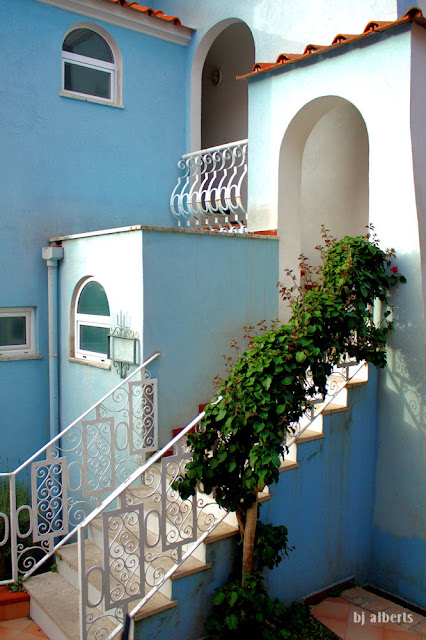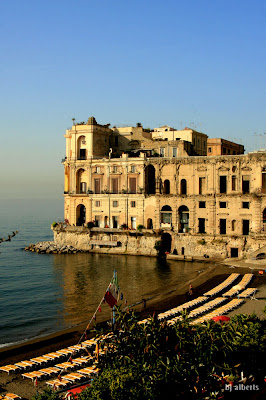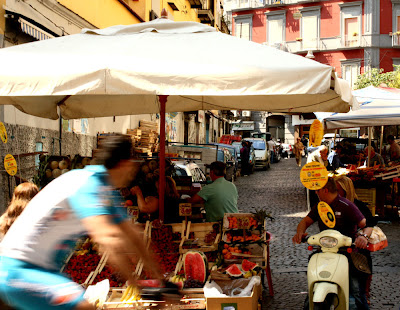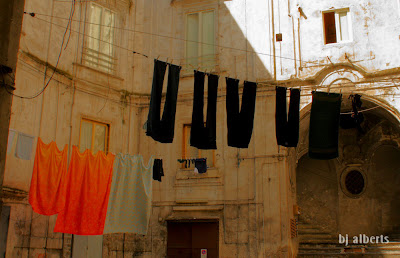The Island of Nisida
The most popular destinations in the Bay are definitely Sorrento and Capri. The characteristic small town charm and laid back beach resort lifestyle in Sorrento attracts a large English crowd, and it’s where we go when we need an English break. Capri on the other hand is a renowned tourist destination of immense natural beauty. With crystal clear blue waters, panoramic vistas, the famed Blue Grotto, a chic upscale atmosphere, and high end hotels and designer stores, Capri attracts the rich and the famous, and has the price tag to match.
By contrast, the tiny and oft forgotten island of Procida attracts far less crowds. The antithesis of Capri, it is little more than a small fishing village really, and with no upscale hotels or designer stores, it has a quaint charm and local character that makes it the perfect place for a day trip.
Then there is Ischia. The largest of the Campanian islands, it is the perfect middle ground between touristy Sorrento, upscale Capri and tiny Procida. It boasts some of the best thermal spas in the area, is considered almost rural by some, attracts less crowds – mostly locals and Germans, and everything is reasonably priced (except the taxis). In other words, it’s a great weekend getaway from the city.
And getaway we did. Not just one weekend, but the last two. I don't know what it is, but something keeps drawing me back here. Maybe it's the respite from my chaotic city life, maybe it's the short journey to a whole other world, or maybe, I just love the hotel.
In today's world of nightmare travel this has to be one of the most pleasant journeys by far. No waking up at dawn to catch a flight or train; no airport security lines or the customary metal detector and strip search; no traffic jams or toll boothes. A five minute bus ride from my apartment and a short walk and I'm at the Mergellina port waiting for an Alilauro Aliscafi (hydrofoil). The only thing I have to contend with is the classic Neapolitan queue - or lack there of - and I choose simply to wait it out and let everyone else cram on.
Such was the case when I left on Friday. The line didn't look that long so I had no real worries, but I forgot that the ferry was coming from Naples main port, Porto Molo Beverello and all ready filled with passengers. By the time we made it on the boat - there was no room at the inn. But it was a blessing in disguise, as we were "forced" to stand outside on the deck and soak in the stunning views.
We reached our destination, Ischia Porto, in about 35 minutes or so (it's a little quicker from Mergellina than from Molo Beverello). There are two other ports on Ischia, Casamicciola and Forio which we will visit another day, but today we go to Ischia Porto, the largest "city" on the island.
A Caremar Ferry pulls into Ischia Porto
Just beyond the pier, the taxis are lined up and waiting for your business - minivans, sedans, and little three wheelers. But this is one expense I just can't abide. The €15,00 fare to take me the kilometer or so to my hotel seems outrageous compared to the €5,00 or €7,00 I'd pay in Naples. Instead I grab a few bus tickets at the newspaper stand and walk a block to the main piazza and get on a bus. €1,30 euro and I'm at my summer hideaway in 10 or 15 minutes.
Normally we rent an apartment when we travel, but a few years back we tried this hotel, the Continental Terme, on a whim and we have never been able to bring ourselves to stay anywhere else. Just like a comfortable pair of old shoes, it just fits us perfectly. Though its billed as a four star hotel, more for its amenities than its rooms I'm sure, it doesn't put on airs. Rather it feels like coming home to family and old friends and takes you back to the simpler times of the 1950s and 60s. It always reminds me of Dirty Dancing and the great resorts of the Poconos.
The property I was told, dates back to the late 50s or early 60s and started with just 20 rooms. Today, there are some 250 rooms spread across three hectares that cross two comunes – Ischia and Barano. But its thoughtful design makes it feel small and intimate. Rooms are spread out over the complex in small two story buildings painted in classic Mediterranean colors - pale blues, soft peaches, terracottas, and sunset pinks.
Fuchsia and purple bougainvillea and lush greens climb the walls and the entire property is drenched in the local flora. Nearly every room has a balcony or terrace - some large and sunny, some small and shady.
Our days are spent lying by the hotel's main pool (one of five thermal pools on the property) - a half Olympic size pool that is kept at about 28°C. To break things up we head up to the gorgeous 36°C tropical pool which is set inside a greenhouse filled with tropical plants.
The rest of the time we spend at the the Olympic Bar that overlooks the main pool. And it was there that we spent Sunday afternoon watching Italy play in the World Cup amidst the thunder, lightning and pouring rain of a rare early summer storm.
Luckily for us, we had done our jaunt down to the port for dinner on Saturday evening so we were happy to ride out the weather at the hotel. Vibrant and bustling but with a small town feel, the whole port area comes alive at night. Stores along tree lined shopping streets keep their doors open until 10:00 or 11:00 p.m.
Bars and cafes fill with tourists and locals alike for the pre-dinner gelato, afternoon caffe, or an early evening drink. And by 10:00 p.m. every one of the restaurants that line the port are filled with diners enjoying the local speciality - seafood.
Before we feasted on a huge meal though, we stopped for a drink and watched an incredible sunset.
There is much to see and do on Ischia, but this trip was just about rest and relaxation. We will definitely explore the island in future posts, but in the meantime, learn a bit about Ischia's history in Ischia, by Gabriella Sannino.
Until next Saturday :)



























































